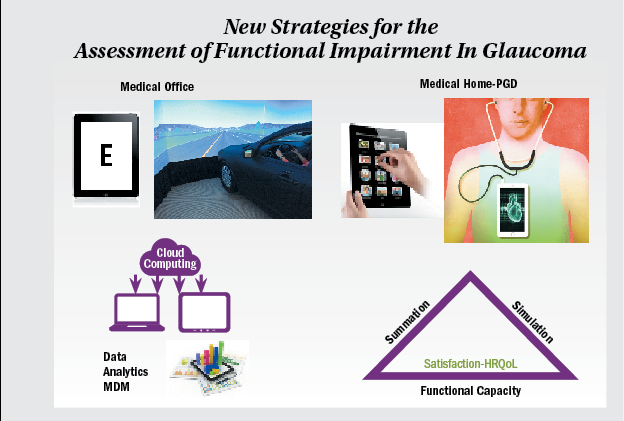Article
Uncertainty of glaucoma patient accidents easier to discern with new tests
New strategies for assessment of functional impairment will help clinicians and patients better understand how eye diseases affect driving and other activities of daily living.
Take-home message: New strategies for assessment of functional impairment will help clinicians and patients better understand how eye diseases affect driving and other activities of daily living.
By Nancy Groves; Reviewed by Peter N. Rosen, MD
San Diego-New tests to assess visual performance-more closely resembling real-world conditions-may help clinicians discern the risk of motor vehicle accidents and falls in individuals with glaucoma and other eye diseases, said Peter N. Rosen, MD, associate clinical professor, Shiley Eye Institute, University of California, San Diego (UCSD).
Did you know these 7 men were ophthalmologists?
Conventional testing methods, such as Snellen acuity and standard automated perimetry, are poorly correlated with activities of daily living, driver safety, and risk of falls-partly because of their lack of secondary task demands, such as divided attention and visual processing speed.

Also, these tests are usually performed under ideal conditions. Additionally, the information derived from these tests may not always provide sufficient insight into their impact on task performance and vision-related quality of life.
“In ophthalmology and other fields of medicine, we often treat arbitrarily defined ‘abnormal’ test results (e.g., visual acuity) whose correlation with impaired task performance and quality of life is poorly understood,” Dr. Rosen said. “Our lab is trying to improve our understanding of the relationship between visual performance, task performance, and quality of life since it is not always clear when treatment or counseling is required that makes a difference in the last two.”
Should aging doctors be tested for competency?
Processing speed
One of the newest methodologies used in the Visual Performance Lab at UCSD is the iPad-based PERformance-CEntered Portable Test (PERCEPT). The PERCEPT processing speed test is designed to improve the sensitivity of detecting visual impairment in the macula and reflect real-world conditions of rapidly changing scene, complexity, and low contrast, Dr. Rosen noted.
Next: Driving simulation
The developers also want to evaluate PERCEPT’s utility to assess the risk of motor vehicle accidents and falls in individuals whose vision has been altered by eye disease.
Multiple dimensions of vision are combined in the test, Dr. Rosen said.
Keep up the with latest surgery news here
For instance, it combines low contrast-divided attention targets with visual processing speed to increase perceptual demand and sensitivity to detecting functional impairment.
In an evaluation of the test, researchers studied 71 glaucoma patients and 59 controls. Larger differences between the groups were seen with PERCEPT processing speed than with the Useful Field of View test, a gold standard for assessing driver risk of motor vehicle accident involvement.
In addition, larger values of PERCEPT processing speed were associated with higher probability of motor vehicle accidents, as determined by a search of motor vehicle records. Larger values on the test were also significantly correlated with a higher probability of falls.
Driving simulation
The Visual Performance Lab is also using driving simulators to assess task performance.
7 steps to boost optical revenue
“The use of driving simulation may provide a better understanding of factors associated with vision impairment and poor-driving performance,” Dr. Rosen said. “The advantage of driving simulation is that it offers us the ability to put people in risky situations without risk to the driver and to develop a unique set of metrics by which we can compare task performance with visual performance.”
The new driving simulator is motion-based and has a fully functional car chassis. The simulator includes a wrap-around 180° forward field of view and a rear-view projection system. This allows researchers to use side and rear-view mirrors to assess how well drivers are performing when their attention is divided between following the speed profile of the car ahead while simultaneously reacting to peripheral targets in the mirrors.
Next: Tablet technologies
“Driving is a complex visual task requiring rapid visual processing and divided attention,” Dr. Rosen said. “Yet, it is not clear what level of structural damage impairs these visual functions or how these impairments influence driving performance.”
Best ophthalmic hospitals for 2015
In a study of 158 subjects using the simulator, Tatham, Rosen, Medeiros, et al. demonstrated that glaucomatous retinal nerve fiber layer thickness loss was associated with slower reaction times under divided attention tasks, demonstrating a good association between a structural measure and a functional measure.
Tablet technologies
Dr. Rosen predicted that improved methods of evaluating visual performance with tablet-based, cloud-enabled technologies will be available in the near future. Simulators may also be practical outside of labs and research settings.
Tablet-based technologies for managing data collection and analysis of visual function will be applied both in the medical office and the medical home, utilizing voice and pen input to make the process easier, Dr. Rosen said.
Incorporating the business of medicine
“Tablet technologies will allow anyone, including patients and primary-care providers, to accurately and precisely measure visual performance and health-related quality of life,” he said. “This will fill an important need in areas of the world where technology is not readily available.”
Multidimensional models that include visual performance, task performance, and health-related quality of life are likely to improve ways to measure functional impairment beyond structure and function alone, and they will do it in ways that are more salient to the clinician and especially to the patient, he noted.
Peter N. Rosen, MD
This article was adapted from Dr. Rosen’s presentation at the 2015 meeting of the American Glaucoma Society. Dr. Rosen did not report any relevant commercial relationships.
Newsletter
Don’t miss out—get Ophthalmology Times updates on the latest clinical advancements and expert interviews, straight to your inbox.




